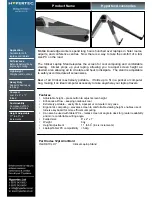
Glossary 6
User's Manual
Satellite Pro 4200/4300 User's Manual – 4200_UK.doc – ENGLISH – Printed on 27/01/00 as
IM_420UK
E
echo:
To send back a reflection of the transmitted data to the sending
device. You can display the information on the screen, or output it
to the printer, or both. When a computer receives back data it
transmitted to a CRT (or other peripheral device) and then
retransmits the data to printer, the printer is said to echo the CRT.
EGA:
Enhanced Graphics Adaptor. A video display protocol defined by the
IBM Enhanced Graphics Adaptor and its associated circuitry for
direct drive TTL displays that supports 16-colour/monochrome
640x350 and 16-colour 640x200 and 320x200 graphics, and
16-colour 640x350 and 320x350 text modes.
erase:
See
delete.
escape guard time:
A time before and after an escape code is sent to the
modem which distinguishes between escapes that are part of the
transmitted data, and escapes that are intended as a command to
the modem.
escape:
1) A code (ASCII code 27), signalling the computer that what
follows are commands; used with peripheral devices such as
printers and modems. 2) A means of aborting the task currently in
progress.
execute:
To interpret and execute an instruction.
Extended Capability Port:
An industry standard that provides a data
buffer, switchable forward and reverse data transmission, and run
length encoding (RLE) support.
F
fast infrared:
An industry standard that enables cableless infrared serial
data transfer at speeds of up to 4 Mbps.
file:
A collection of related information; a file can contain data, programs,
or both.
firmware:
A set of instructions built into the hardware which controls and
directs a microprocessor’s activities.
fixed disk:
See
hard disk.
floppy disk drive (FDD):
An electromechanical device that reads and
writes to floppy disks.
See also
diskette.
floppy disk:
See
diskette.
folder:
An icon in Windows used to store documents or other folders.
format:
The process of readying a blank disk for its first use. Formatting
establishes the structure of the disk that the operating system
expects before it writes files or programs onto the disk.
function keys:
The keys labelled
F1
through
F12
that tell the computer to
perform certain functions.















































